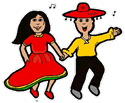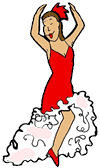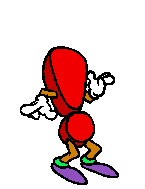|
| |
 Doctora
Hickman's
Spanish Class Doctora
Hickman's
Spanish Class
 |

|
|

















|
|
  

Libro - Así se dice
¡Así se dice! helps you teach Spanish your way with
manageable content and easy-to-use technology. Cultural and interactive
experiences blend learning opportunities to transport students to the
exciting diverse world of Hispanic culture.
Whether your school uses print, digital, or a combination of both, motivate
students with a powerful standards-based curriculum, photos from around the
Spanish-speaking world, hands-on interactive projects for a deeper
understanding of the culture, and connections with peers from different
countries, all without leaving their classroom.
Students connect and compare cultures with motivating
applications found throughout the program.

World Language Department
Syllabus Introduction to
Spanish – Doctora Sherida Hickman - Rm. 107
Course Content and Timeline
A. Introduction to Spanish Unit
• Greet people appropriately based on formality and time of day, including
gestures appropriate to the culture.
• Say good-bye to people based on formality and time of day.
• Express yourself politely depending on the audience.
• Identify and use numbers from 0 to 100 to express a variety of
information.
• Identify and use the days of the week and the months of the year in order
to relay information.
• Find out and give specific dates.
• Ask and tell time.
• Tell and ask for specific times when events occur.
• Discuss the weather and the seasons.
• Identify the Spanish-speaking countries and principal cities on a map.
• Recognize various currencies of the Spanish-speaking world.
• Recognize and apply the unique phonetic sounds of the Spanish alphabet.
B. Physical / Personality Characteristics Unit
• Identify adjectives to describe people and things.
• Apply adjective agreement in order for nouns to agree with adjectives.
• Identify adjectives with their opposites.
• Ask for and tell information about other people.
• Identify nationalities throughout North and South America.
• Express opinions about people.
• Name the school subjects on their schedule.
• Tell what time various classes take place at school.
• Utilize question words to inquire about people and things.
• Describe school subjects and their level of difficulty.
• Apply definite article rule for placement in front of nouns utilizing
correct gender
and number agreement.
• Apply indefinite article rule for placement in front of nouns utilizing
correct gender
and number agreement.
• Use the irregular verb “ser” in its conjugated forms.
• Use correct subject pronouns with corresponding forms of the irregular
verb
“ser”.
• Compare and contrast the concept of friendship between the United States
and Latin
America/Spain.
C. Family/Home Life Unit
• Identify family members and pets.
• Describe a house or apartment.
• Describe rooms and some furniture.
• Compare family life in Ecuador to the U.S.A.
• Discuss the important role of pets in the Spanish-speaking world.
• Use the verb “tener” to express possession, age, and limited physical
characteristics.
• Use possessive adjectives to tell who or what possesses something.
• Recognize that a possessive adjective must agree with the noun it
describes in gender and
number.
• Compare and contrast urban vs. suburban housing in the U.S.A. and in
Spanish-speaking
countries.
D. School Unit
• Describe what you do in school.
• Identify some school clothes, specifically pertaining to a school uniform.
• Tell what school supplies are used in both American and Spanish-speaking
schools.
• Discuss what you and your friends do after school, including use of
electronics and shopping.
• Explain how students get to school and why.
• Compare and contrast school and after-school activities in
Spanish-speaking countries and in the United States.
• Compare and contrast working habits of young people in Spanish-speaking
countries to the
United States.
• Identify an –ar verb and be able to conjugate it for the different
pronouns to make sentences
about the topics discussed in this chapter.
• Explain a contraction of words and use the two mandatory contractions
correctly in Spanish.
E. Food Unit
• Identify typical breakfast foods from the United States.
• Identify typical lunch foods from the United States.
• Identify typical dinner foods from the United States.
• Identify names of meals.
• Identify hot and cold beverages from the United States.
• Express feelings of hunger and thirst.
• Ask someone what they eat for breakfast, lunch, and dinner.
• Categorize foods by fruit, vegetable, meat, fish, and dessert.
• Identify typical “tapas” foods enjoyed throughout Latin America and Spain.
• Order foods at an outdoor café or restaurant.
• Request the check in an outdoor café or restaurant.
• Request a table at an outdoor café or restaurant.
• Conjugate and use regular –er verbs in Spanish.
• Conjugate and use regular –ir verbs in Spanish.
• Conjugate and use the irregular verb “ver” in Spanish.
• Use the expression “tener que” to express things they have to do.
• Use the expression “ir + a + infinitive” to express the simple future
tense.
• Use the expression “acabar de” to express activities they have just
completed.
• Use proper telephone etiquette to make plans to meet friends for a meal or
snack.
F. Sports Unit
• Discuss soccer, baseball, basketball and tennis.
• Describe a soccer uniform.
• Identify colors.
• Compare/contrast team sports in the United States with Spanish-speaking
countries.
• Conjugate some stem-changing verbs in the present tense.
• Use verbs such as to interest, to bore, and to like to express feelings
about activities.
• Identify the main ideas and other significant ideas when reading about
Roberto Clemente.
COURSE OUTLINE:
First Quarter: Lección 1 and 1st half of Lección 2
Second Quarter: 2ndhalf of Lección 2 and Lección 3 – Semester Exam
Third Quarter: Lección 4 and 1sthalf of Leccion 5
Fourth Quarter: 2ndhalf of Leccion 5 and Leccion 6 – Final Exam
Syllabus
Spanish 1 – Doctora Hickman - Rm. 107
Email - sherida.hickman@pgcps.org
Our textbook focuses on the five goals
of communication, cultures, connections, comparisons,
and communities. Communication is the main goal of second
language learning and consists of four integral skills: listening,
speaking, reading, and writing with culture embedded in
each skill. Through the study of a second language, students begin to
understand and appreciate the diversity of the many cultures of people who
speak the language (Cultures). Students also will access new
information and explore issues related to many other subject areas (Connections).
Studying a second language provides insight into other cultures and the
nature of language (Comparisons). Finally, knowledge of a second
language opens doors to a world of other multilingual communities, here and
abroad (Communities).
COURSE OBJECTIVES:
After completion of this course, students will be able to:
 |
Introduce oneself and
greet others. |
 |
Give the date and tell
time. |
 |
Express likes and
dislikes. |
 |
Describe persons and
things. |
 |
Recognize Spanish-speaking
regions, countries, and nationalities. |
 |
Identify clothes and
colors. |
 |
Identify rooms and parts
of a house. |
 |
Express family
relationships. |
 |
Discuss student life. |
 |
Identify foods from
Spanish-speaking countries. |
 |
Discuss sports,
activities, social events, and pastimes. |
I
In
order to reach these goals, many different materials will be used. For
example, videos, films, magazines, newspapers, taped stories, visual aids,
and an exercise workbook will be incorporated into the course to help the
students develop language skills that are useful to themselves and can be
applied to various activities and disciplines.
Syllabus Spanish 2 –
Doctora Sherida Hickman - Rm 107
The World Language (WL) program in Prince George’s County Public School
System is dedicated to the development of second language proficiency. In a
curriculum driven by National Standards for Foreign Language also known as
the 5 C’s (Communication, Connections, Comparisons, Communities and
Cultures) and aligned with the Common Core State Standards, students move
toward proficiency in the target language through a variety of contextual
activities that allow them to demonstrate communicative competence through
appropriate performance-based assessments.
Communicative acquisition of language is the focus of the WL program, with
reading and writing at the core of proficiency development. The development
of reading and writing skills within the world languages classroom is an
absolutely integral aspect of the world languages curriculum. To this end,
language input is presented in a variety of forms, and fundamental to the
program is the presentation of visualized vocabulary and the integration of
grammar structures into contextual situations. The Level II program builds
upon existing vocabulary and grammar structures that students have learned
in the prerequisite Level I. In Level II, students are expected to
demonstrate a more profound knowledge of language as they move towards
communicative proficiency. Students will be able to demonstrate achievement
in each of the three modes of communication, Interpersonal, Intrapersonal,
and Presentational. In accordance with the National Standards for Foreign
Language, and the Common Core State Standards, students will also be able to
demonstrate competence in each of the five domains of performance:
comprehensibility, comprehension, language control, vocabulary usage,
communication strategies and cultural awareness.
Maryland Technology Literacy Standards for Students
Standard 1.0 – Technology Systems: Develop foundations in the understanding
and uses of technology systems.
Standard 2.0 – Digital Citizenship: Demonstrate an understanding of the
history of technology and its impact on society, and practice ethical,
legal, and responsible use of technology to assure safety.
Standard 3.0 – Technology for Learning and Collaboration: Use a variety of
technologies for learning and collaboration.
Standard 4.0 – Technology for Communication and Expression: Use technology
to communicate information and express ideas using various media formats.
Standard 5.0 – Technology for Information Use and Management: Use technology
to locate, evaluate, gather, and organize information and data.
With the acceptance of the Maryland Educational Technology Plan for the New
Millennium: 2007-2012, by the State Board of Education on April 24, 2007,
the State now has technology literacy standards for students, teachers and
administrators. These standards define what students, teachers and
administrators need to know and be able to do using technology.
The 5 C’s of the National Standards of World Languages are a follows:
COMMUNICATION: The Communication standard is the heart of the world language
classroom. Central to world language learning is using the second language
to communicate, to learn, and to become part of another culture, rather than
talking about the second language or another culture in English.
Communication comprises three modes that represent different purposes of
language:
• to engage in conversation, exchange ideas, or negotiate meaning with
another person (interpersonal mode).
• to understand information received through reading, listening, or viewing
(interpretive mode), and
• to express ideas or deliver information through speaking, writing, or
showing (presentational mode).
CULTURES: The Cultures standard stresses the awareness of differing
perspectives behind the products and practices of the target cultures. The
goal is to consider why the similarities or differences exist and how they
help students understand another culture’s perspective or view of the world.
CONNECTIONS: The Connections standard links world language study with other
disciplines to create interesting, meaningful and authentic contexts for
communication in the classroom. As a result, the pool of potential content
in a language classroom is virtually limitless, allowing students to use
language as a tool for learning in a more natural context.
COMPARISONS: The Comparisons standard helps students recognize that language
and cultures interrelate and evolve to meet the dynamic needs of people and
society. As a result, students encounter not only cultural and linguistic
differences, but also similarities between the language and culture studied
and their own.
COMMUNITIES: The Communities standard reminds teachers to look beyond the
four walls of the classroom to ensure that students learn how to apply the
skills and knowledge gained in the classroom. This may take the form of
actual or virtual field trips locally and abroad, student or teacher
exchanges, authentic materials used for specific purposes, or written or
verbal communication with people from another culture. The teacher designs
lessons that help students use their new language in purposeful and
meaningful ways to provide personal enrichment and lifelong learning.
SCOPE AND SEQUENCE: FIRST QUARTER
By the end of the First Quarter students will:
• Communicate orally about self and to express ideas related to topics
• Apply grammatical principles involving the use of verb tenses beyond the
present
• Understand spoken material based on the Level II textbook and ancillary
recordings
• Express original ideas related to a given topic orally and in written form
• Recognize new words in reading passages through context and use of a
variety of reading strategies
• Write complete sentences from oral practice, dictation, selected real-life
scenarios using correct spelling, including accent marks
• Express likes and dislikes and reactions to past events
• Manage a simple telephone conversation in the target language
• Identify cultural differences and demonstrate knowledge of target
culture(s)
SECOND QUARTER
By the end of this quarter, students will:
• Describe people, places, and situations in the past
• Explain why you are unable to do certain things
• Apply grammatical principles in context using verb tenses beyond the
present and also using command forms
• Discuss video clips (Reference: United Streaming)
• Recognize new vocabulary in reading passages through context and the
application of other reading strategies
• Write complete sentences from oral practice, dictation, and selected
real-life scenarios
• Confront graded reading material with some skill in using contextual
clues, cognates, prefixes, suffixes, and roots
• Use various forms of the past tense to discuss past events and ongoing
situations
• Compare rules and customs in other countries with those of your own
country
• Understand cultural perspectives on extracurricular activities
THIRD QUARTER
By the end of this quarter, students will:
• Read narratives and authentic selections from various sources
• Plan for a fantasy trip to a foreign country
• Discuss video plots and characters in structured situations in the target
language
• Avoid repetition when comparing similar things in oral and written form
• Recognize new vocabulary in reading passages through context
• Write complete sentences from oral practice, dictation, and selected
real-life scenarios
• Confront graded reading material with some skill in using contextual
clues, cognates, prefixes, suffixes, and roots
• Distinguish meanings of various forms of the past tense
• Understand cultural perspectives on traveling through various readings and
videos
• Describe how you and others spend time
• Read and respond to brief authentic texts about current events
FOURTH QUARTER
By the end of the Fourth Quarter students will:
• Write a guided paragraph that reflects correct spelling and grammar usage
Identify the main idea and some supporting ideas of selected authentic
materials from various media
• Discuss the information gained through active listening or reading to
communicate through speaking or writing
• Avoid repetition when comparing similar things in oral and written form
• Recognize new vocabulary in reading passages through context and visual
clues
• Write complete sentences from oral practice, dictation, and selected
real-life scenarios
• Identify and make comparisons with the historical or contemporary figures
and events that have influenced current cultural practices
• Understand cultural perspectives on reading activities
• Make predictions about the future using appropriate language structures
• Complete the End of Year Assessment mandated by the World Language Office
of Prince George’s County Public School System
SUBJECT CONTENT
agosto/ septiembre – Vamos a recorder pp. 1 – 27
describe and identify; express likes and daily actions; express places and
existence
octubre – Unidad 1 – Centroamérica pp. 28 – 79
vocabulario – personal and family relationships, physical characteristics
and personality traits, emotional states and feelings, personal information
gramática – possessives, adjectives and nouns, comparisons and superlatives,
interrogatives
cultura – Centroamérica: Mestizaje y cultura; Riqueza natural
lectura – El blog de Ichxel
noviembre – Unidad 2 - Las Antillas pp. 80 – 131
vocabulario – The house, household chores, furniture and objects in a house,
electrical appliances, the neighborhood, places and services
gramática – The present progressive, direct object pronouns, indirect object
pronouns, demonstratives
cultura – Las Antillas: Barrios colonials; Música caribeña
lectura – Estilo de vida caribeño
diciembre – Unidad 3 – Andes centrales pp. 132 – 183
vocabulario – Cloting and accessories, describing clothes, stores and
establishments, shopping
gramática – The preterite tense of regular –ar, -er, and –ir verbs, the
preterite tense of the verbs ser, ir, decir, tener, estar, and hacer, the
preterite tense of stem- changing –ir verbs
cultura – Andes centrales: Quechuas y aymaras; Los equecos; Las islas
Galápagos
lectura – Textiles andinos bolivianos
enero – Unidad 4 – Norteamérica pp. 184 – 235
vocabulario – Foods, buying food, in the kitchen, in the restaurant
gramática – Expressing amounts (indefinites), singular affirmative commands,
plural affirmative commands, negative commands
cultura – Norteamérica: El Camino Real de Tierra Adentro; Los chicanos
lectura – La receta del guacamole
febrero – Unidad 5 – España pp. 236 – 287
vocabulario – Parts of the body, personal hygiene, health-symptoms and
illnesses, healthy habits
gramática – The past participle, adverbs ending in –mente, por and para,
making recommendations
cultura – España y el Mediterráneo: Paisaje mediterráneo; La Noche de San
Juan; Las lenguas romances
lectura – Figura en una ventana de Salvador Dalí
marzo – Unidad 6 – Caribe continental pp. 288 – 339
vocabulario – Trips and excursions, on the train and on the plane, the car,
the hotel, the bank
gramática – The imperfect tense, the preterite tense of the verbs dar, poder,
poner, querer, saber, and venir, talking about past actions (imperfect and
preterite tenses) talking about past actions and describing in the past
(imperfect and preterite tenses)
cultura – Caribe continental: Símbolos nacionales; El mestizaje y los bailes;
Cocina del Caribe – color y sabor
lectura – El Dorado, ecos de una leyenda
abril – Unidad 7 – Río de la Plata pp. 340 – 391
vocabulario – The school, professions, hobbies, free-time activities, and
entertainment, sports
gramática – Expressing existence (indefinites), the present subjunctive of
regular verbs, the present subjunctive of stem-changing verbs, the present
subjunctive of irregular verbs
cultura – Río de la Plata: Influencia italiana; Culura rioplatense; El chipá
lectura – Un cuento de Benedetti
mayo – Unidad 8 – La Panamericana pp. 392 – 443
vocabulario – Geography, countries, the weather, nature and environment
gramática – The relative superlative, expressing plans and intentions, the
future tense, hiding the agent, the pronoun se
cultura – La ruta Panamericana: Variedad geográfica; El mundo hispano-inidad
y diversidad
lectura – El Tapón de Darién: un corte en la ruta Panamericana
junio - REPASO


Syllabus: Spanish I
Instructor: Doctora Hickman
Department: World Language Room
107
Grades 7-8
Classroom Policies and Procedures
Try
to be a RARE
student!
 |
Respect
yourself,
your classmates, your teacher, and your school. |
 |
Be
Accountable
for all
class requirements. |
 |
Take
Responsibility
for your
actions. |
 |
Put forth
Effort
by always
trying your best. |
Class Materials:
You
need to come prepared to class every day. This means you must bring the
following items with you each day:
 |
Textbook |
 |
Notebook - Students
must have a 3 ring binder for Spanish class exclusively. It will be
divided into four sections: (1) Classwork, (2) Vocabulary & Grammar, (3)
Homework (4) Test and Quizzes. Notebooks will be checked twice every
quarter. |
 |
A supply of lined notebook
paper (college ruled) |
 | #2
pencils and blue or black pens
(no red ink!) |
 |
Dry-erase
eraser
and a Dry Erase Board |
 | Subject dividers |
 | Composition books (college ruled) |
 | Colored pencils |
 | Highlighter |
 | Ruler |
 | Book covers |
 | Dictionary - Students will need a Spanish-English dictionary with a
minimum of 100,000 entries. Larousse and Oxford are excellent
dictionaries.
|
Classroom Expectations and Consequences:
I expect all
students to behave in the following manner:
 |
Arrive on
time with all the necessary materials. |
 |
Do not leave
your seat without permission. |
 |
Follow
directions the first time you hear them. |
 |
Keep your
mouth free of gum, candy, paper, or abusive language, do not whistle,
and do not engage in personal grooming in class. |
 |
Show respect
for the teacher, fellow students, and classroom items. |
 |
Take
responsibility for your own learning. |
 |
Trash will
be thrown away at the end of the class period. Students will not
be permitted to leave until all trash is picked up and placed in the
trashcan. |
 |
The
teacher will dismiss the class, not the bell. Please do not bolt for
the door. |
This
is how a respectful student acts:
·
Student arrives on time to class, and is seated and ready to work before the
tardy bell stops ringing.
·
Student is quiet when the teacher or another student is talking to the
class.
·
Student never talks or yells out in class. Student raises their hand and
waits to be called upon to speak.
·
Student remains in his/her assigned seat at all times unless otherwise
instructed.
·
Student does not throw any objects within or around the classroom.
·
Student does not bring anything to class that will distract the teacher or
other students in any way.
·
Student will not use any obscene or inappropriate language gestures in the
classroom.
Objectives:
·
Every day, the objectives (what you are doing today) will be listed
on the board.
·
On
a piece of loose-leaf notebook paper, copy the DATE (in Spanish) and what
your class is expected to learn that day.
·
Please make sure that entries are neat.
·
Please number your entries starting at #1.
·
These will be handed in at the end of the 6 weeks for two daily
grades.
Teacher Notes:
·
I
do not give notes very often. However, when notes are given on the board, it
is expected that students will pay attention and write down the information
given. Often, the notes on the board are NOT in the book.
·
Students are to be attentive and respectful of the speaker, whether it is
the teacher or another student asking or answering a question.
·
If
you miss class for any reason, please get notes from another student. I will
provide additional notes for absences if necessary.
Asking or Answering a Question
·
Students are to raise their hands to ask or answer a question. Please do not
just blurt out questions or answers.
·
Other students should be respectful and quiet while someone is asking or
answering a question.
Headings on Papers and Assignments:
·
All assignments should be neat and readable.
·
Put your full name (Spanish First Name and Your Last Name, not just your
first name preferably in the upper right hand corner. Points will
be deducted for no names.
·
Please indicate your period number under your name.
·
Indicate the date the assignment is given on.
·
Please title your assignment with the applicable title at the top of your
assignment.
Partner work:
·
You will have a partner throughout the semester.
·
You will work with your partner often to practice your speaking in Spanish
most of time.
·
It
is expected that you do the activity with your partner when instructed to do
so and if you finish early, study with your partner and use extra class time
to practice your vocabulary.
·
Partners will change (about) every two chapters.
Attendance:
Because learning a second language is a
cumulative process, it is important and necessary that students attend class
every day. An unexcused or unlawful absence, (any absence whereby the
student does not supply a written note from a parent or guardian explaining
the reason for the absence with the parent or guardian’s contact
information) will result in the student receiving the grade of ‘zero’ (0)
for the days missed. An unlawful absence will be documented as such and no
make-up work will be assigned.
Make-up Work:
It is the student’s responsibility to make up whatever
work was missed due to an excused absence. In the case of multiple days, the
student has the number of days out to make up the work. (i.e. a student is
out for 2 days, he or she has 2 days to make up the missing work.) The
student and teacher will schedule the time for the completion of the make-up
work.
Tardies:
 |
Tardiness
will be excused only if you bring a legitimate note from a teacher when
you arrive tardy. |
 |
Since I
stamp homework at the beginning of class, unexcused tardies will
not
get their
assignments stamped.
No stamps = no points! |
 |
The
consequence for tardies is a deduction of points from the weekly
participation grade.
 |
1st
tardy: 2 point deduction |
 |
2nd
tardy: 5 point deduction |
 |
3rd
tardy: 10 point deduction |
 |
Each
additional tardy will also result in a
10 point
deduction.
|
|
Extra help:
 |
You may also
call me at home in the evenings until 9:30 p.m.
(513-668-7937) |
 |
Please come
for help as soon as you have questions.
Do not wait until you are totally lost! |
 | Email - sherida.hickman@pgcps.org |
Cheating:
All work is
to be your own. Cheating will result in a zero on any assignment. Examples
of cheating include:
 |
Copying
homework. |
 |
Giving or
receiving test information. |
 |
Looking at
someone's test. |
 |
Having
identical or nearly identical sentences in writing assignments. |
 |
Misusing
software or Internet programs which translate for you. |
 |
Having
excessive assistance from a native speaker or a person with more
advanced language skills |
 |
Using a
"cheat sheet" or writing on hands, desk, or clothing.
|
Grading Policy:
The grading policy for the World Language Department is based
on the five (5) content areas set forth in the National Standards for
Foreign Language. Those areas are as follows: Communication, Connections,
Cultures, Comparisons and Communities. The following are factors and their
corresponding percentages: Classwork 35%; Homework 20%; Assessment 45%.
Tests, quizzes, homework, classroom assignments, oral presentations and
projects will be assigned and graded in the appropriate category.
It is your responsibility to check your grade
frequently on-line and keep track of your missing work. The total points of
students will be divided by the total points possible to obtain a percentage
grade of:
90% - 100% = A
80% - 89% = B
70% - 79%= C
60% - 69% = D
0-59% =
E
The letter grades used on report cards are A, B, C, D, E, I,
P, F, and W, with no plus or minus signs.
A -- Excellent progress toward meeting course objectives and learning
outcomes (90-100%).
B -- Above average progress toward meeting course objectives and learning
outcomes (80-89%).
C -- Average progress toward meeting course objectives and learning outcomes
(70-79%).
D -- Below Average progress toward meeting course objectives and learning
outcomes (60-69%).
E -- Failure toward meeting course objectives and learning outcomes (below
60%).
I -- Incomplete. (The "I" grade may be used temporarily for secondary
students who have been lawfully absent from school and have not had an
opportunity to make up missed work in a timely manner. The "I" grade will
not be included in the calculations of the student's Grade Point Average.)
P - Pass (credit bearing). F -- Fail (not credit bearing).
W -- Withdrawn. Student drops a course after twenty (20) school days from
the start of the course or ten (10) days in a semester course. "W" does not
factor into grade averaging.
A student will receive a failing grade (“E”) for assignments, tests, or
quizzes when he or she has cheated; fails to produce work by the deadline;
has been lawfully absent but fails to produce make-up work by the deadline;
has been unlawfully absent; or demonstrates unsatisfactory progress (below
60%).
Extra Credit:
There will be
no extra credit assigned to any individual student. If the required
assignments are completed there is no need for extra work.
Tutoring
I will be available for any student needing extra help on
Monday thru Thursday after school in room 112 in the Main building from
3:15pm - 4:30pm. Please do not be afraid to
speak up if you do not understand something. Spanish is like building
blocks. If you miss class or are getting behind, you need to come in during
this time to keep up with the pace because everything builds on each other.
Let me know in advance if you cannot come on Monday thru Thursday and I will
find time to help you out.
Homework:
 |
Homework is
a way to practice the concepts we are learning in class. It helps you
learn vocabulary, it reinforces language rules, and it gives you a
chance to use what you have learned. |
 | There will be daily homework assignments. Some
assignments are written and others require viewing a television show or
listening to an audio clip in Spanish, and some assignments are to be
done online (internet). All assignments must be completed. |
 | All homework
is due at the
beginning
of
class. Students will not receive credit for incomplete assignments even
if there are "...only a couple left to do." I stamp completed
assignments only. Therefore,
no stamps = no points!
|
Class Preparation and Participation:
Students are expected to arrive to class on time; that
means before the bell rings and to be seated for the beginning of class.
They are expected to participate in all classroom activities, both oral and
written. Classes will be conducted 90% in Spanish! Students are to be
prepared for class by bringing a notebook, textbook, dictionary, pen or
pencil and assignments that are due on a daily basis. Students must memorize
vocabulary in order to be successful in class and communicate in the second
language. Students will not be permitted to enter class without materials.
Leaving the classroom for tissues, materials left in the locker or use of
bathroom will not be permitted.
Announcements and Getting Student’s Attention
·
Should an announcement come on over the intercom or if I need to make a
clarification during an activity, please quiet down from your activity
quickly so you can hear.
·
Students will please stop what they are doing and focus on the teacher
and/or the announcement.
Fire
Drills and Emergencies:
·
Should the fire bells sound students are to quietly stop their activity and
walk out the exit route described.
·
Students are expected to refrain from talking until the drill is over.
·
During any other emergency, students should remain calm and listen for
directions.
Food
THERE IS ABSOLUTELY NO FOOD, DRINKS,
GUM, OR CANDY ALLOWED IN THE CLASSROOM OR LANGUAGE
LAB!
I look forward to spending an exciting and fun year with you!!!
|
Home | Acerca De Mí | Actividades | Calendario | El Plan | Enlaces | Frases | La Galería | La Realimentación | Chistes Españoles | Tarea | Web Quests
This site was last updated
08/29/15
|
Doctora
Hickman's
Spanish Class



























